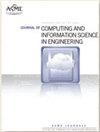Behavioral Modeling of Collaborative Problem Solving in Multiplayer Virtual Reality Manufacturing Simulation Games
IF 2.6
3区 工程技术
Q2 COMPUTER SCIENCE, INTERDISCIPLINARY APPLICATIONS
Journal of Computing and Information Science in Engineering
Pub Date : 2023-10-10
DOI:10.1115/1.4063089
引用次数: 0
Abstract
Abstract Engineering is an inherently creative and collaborative endeavor to solve real-world problems, in which collaborative problem solving (CPS) is considered one of the most critical professional skills. Hands-on practices and assessment methods are essential to promote deeper learning and foster the development of professional skills. However, most existing approaches are based on out-of-process procedures such as surveys, tests, or interviews that measure the effectiveness of learning activity in an aggregated way. It is desirable to quantify CPS dynamics during the learning process. Advancements in virtual reality (VR) provide great opportunities to realize digital learning environments to facilitate a learning-by-doing curriculum. In addition, sensors in VR systems allow us to collect in-process user behavioral data. This paper presents a multiplayer VR manufacturing simulation game for virtual hands-on learning experiences, as well as a behavioral modeling method for monitoring the CPS skills of participants. First, we developed the Virtual Learning Factory, where users play simulation games of various manufacturing paradigms. Second, we collected action logs from a sample of participants and used the same pattern to generate more data. Third, the behavioral data are modeled as dynamic networks for each player. Last, network features are calculated, and a CPS scoring method is driven from them. Experimental results show that the proposed behavioral modeling successfully captures different patterns of CPS dynamics according to manufacturing paradigms and individuals. This detailed assessment contributes to the development of appropriate student-specific interventions to improve learning outcomes.多人虚拟现实制造仿真游戏中协同问题解决的行为建模
工程本质上是一门创造性和协作性的学科,旨在解决现实世界中的问题,协作解决问题(CPS)被认为是最关键的专业技能之一。动手实践和评估方法对于促进深入学习和促进专业技能的发展至关重要。然而,大多数现有的方法都是基于进程外的过程,如调查、测试或访谈,这些过程以聚合的方式衡量学习活动的有效性。在学习过程中量化CPS动态是可取的。虚拟现实(VR)的进步为实现数字化学习环境提供了巨大的机会,以促进边做边学的课程。此外,VR系统中的传感器允许我们收集进程中的用户行为数据。本文提出了一种多人虚拟现实制造模拟游戏,用于虚拟动手学习体验,以及一种用于监测参与者CPS技能的行为建模方法。首先,我们开发了虚拟学习工厂,用户可以在其中玩各种制造范式的模拟游戏。其次,我们从参与者样本中收集操作日志,并使用相同的模式生成更多数据。第三,将行为数据建模为每个玩家的动态网络。最后,计算网络特征,并以此驱动CPS评分方法。实验结果表明,所提出的行为模型成功地捕获了不同制造范式和个体的CPS动态模式。这种详细的评估有助于制定适当的针对学生的干预措施,以改善学习成果。
本文章由计算机程序翻译,如有差异,请以英文原文为准。
求助全文
约1分钟内获得全文
求助全文
来源期刊
CiteScore
6.30
自引率
12.90%
发文量
100
审稿时长
6 months
期刊介绍:
The ASME Journal of Computing and Information Science in Engineering (JCISE) publishes articles related to Algorithms, Computational Methods, Computing Infrastructure, Computer-Interpretable Representations, Human-Computer Interfaces, Information Science, and/or System Architectures that aim to improve some aspect of product and system lifecycle (e.g., design, manufacturing, operation, maintenance, disposal, recycling etc.). Applications considered in JCISE manuscripts should be relevant to the mechanical engineering discipline. Papers can be focused on fundamental research leading to new methods, or adaptation of existing methods for new applications.
Scope: Advanced Computing Infrastructure; Artificial Intelligence; Big Data and Analytics; Collaborative Design; Computer Aided Design; Computer Aided Engineering; Computer Aided Manufacturing; Computational Foundations for Additive Manufacturing; Computational Foundations for Engineering Optimization; Computational Geometry; Computational Metrology; Computational Synthesis; Conceptual Design; Cybermanufacturing; Cyber Physical Security for Factories; Cyber Physical System Design and Operation; Data-Driven Engineering Applications; Engineering Informatics; Geometric Reasoning; GPU Computing for Design and Manufacturing; Human Computer Interfaces/Interactions; Industrial Internet of Things; Knowledge Engineering; Information Management; Inverse Methods for Engineering Applications; Machine Learning for Engineering Applications; Manufacturing Planning; Manufacturing Automation; Model-based Systems Engineering; Multiphysics Modeling and Simulation; Multiscale Modeling and Simulation; Multidisciplinary Optimization; Physics-Based Simulations; Process Modeling for Engineering Applications; Qualification, Verification and Validation of Computational Models; Symbolic Computing for Engineering Applications; Tolerance Modeling; Topology and Shape Optimization; Virtual and Augmented Reality Environments; Virtual Prototyping

 求助内容:
求助内容: 应助结果提醒方式:
应助结果提醒方式:


